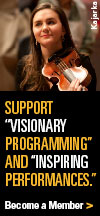One World Symphony News
January 2008
 Grit and Grimes:
Grit and Grimes:
Brooklyn Paper's feature article on Peter Grimes
by Kevin Filipski
One World Symphony continues exploring “Contrasts and Controversy” — this season’s theme — with a production of Benjamin Britten’s classic “Peter Grimes: The Divided Self” in Brooklyn Heights’ Church of St. Ann and the Holy Trinity on Jan. 25. The opera explores several hot button themes, including homosexuality and religious fundamentalism.
One World Symphony conductor Sung Jin Hong’s ambitious decision to present a semi-staged production of “Grimes” — replete with a 55-member orchestra — wasn’t intended to challenge the Metropolitan Opera (which unveils its own starry new production in a few weeks); it was linked to the acclaim One World Symphony garnered when presenting another 20th century operatic masterwork last season: Richard Strauss’s “Salome.”
Read the full article here >>
Reposted with permission from Classical Domain
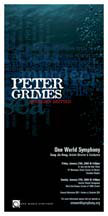 One World Symphony Presents Peter Grimes: The Divided Self
One World Symphony Presents Peter Grimes: The Divided Self
By Anita Moore and Nina Moe
From the depths, surging with mankind's fears and transgressions, One World Symphony and Artistic Director Sung Jin Hong bring New York the scandal, inquest and dramatic despair of Benjamin Britten's masterful Peter Grimes. The symphony's January 25th and 27th performances will deliver not only a darkly compelling narrative but some of the most stunning and deeply moving music ever scored.
The troupe of up-and-coming young vocal artists and thrilling 60-piece full symphony orchestra, conducted by Sung Jin Hong, passionately deliver Britten's challenging and hauntingly beautiful masterpiece. Without relying on sets or lavish costumes to enhance this moderately staged production, Hong and Stage Director, Rod Gomez focus primarily on the sheer power of the music, the stimulating libretto and their theatrically dedicated young cast.
Set in a British fishing village, this opera was inspired by the poem The Borough by the eighteenth-century English poet George Crabbe. Britten's Grimes is a tortured hero protagonist, his soul caught in crisis between personal sovereignty and social conformity. As we begin, fisherman, Peter Grimes, is being tried in court for the death of his young apprentice. It is there we become acquainted with other integral characters, such as, Ned Keene, the apothecary, Auntie, a local pub owner, and Ellen Orford, school mistress and devoted friend to Peter. Soprano Heather Meyer, Ellen of Friday's cast, stated, "Of all Britten's operas, Peter Grimes has the most real characters, in my opinion. Although the setting is the 19th century, the characters are normal, working class individual from every day life that people today can absolutely relate to." The chorus, also a vital character, represents the downtrodden villagers who transform into a vicious mob in their desire to see Grimes punished -- to distract from the gruesome squalor of their own existence; they conclude Grimes is guilty, no evidence needed. Britten's own words underscore the larger social importance of this work: "the more vicious the society, the more vicious the individual."
"Resembling the chorales in a Bach Passion," Hong describes Peter Grimes as a "drama unfolding with articulated frequent interludes. These interludes often stand apart from the ongoing action representing the voice of society (the villagers), the individual (Grimes himself) and the natural world, in particular the vast and profound ocean."
Hong continues "the presence of the ocean permeates the scoring of almost every scene, even when it is not overtly part of the action. In Peter's pivotal aria the clouds of human grief -- breathing solemnity in the deep night... Britten patiently layers each section of the strings from a low to high register -- beginning with the double basses up to the first violins -- accompanying Grimes's agony as he confronts his regrets. Here, and throughout the opera, the lower strings represent the rolling, ever-present sea as an almost visceral counterpart to the human folly we witness on the stage. The composer's sensitive scoring depicts Grimes's personal struggle originating from the depths of the sea with the doublebasses, then reaching for a sense of peace employing the first violins."
Touted as "New York's hippest orchestra," One World Symphony creates adventurous programming that delight neophytes and self-proclaimed "classical music geeks" equally. For example, Queen's magnum opus, Bohemian Rhapsody, and Rachmaninoff's Rhapsody on a Theme by Paganini were on the same program in March of 2008. Ransom Bruce, long-time member, describesOne World Symphony: "This group is always worth coming to see. The orchestra is not just good, they are superb. The singers are uniformly strong. And the concerts are an exciting blend of classic masterpieces and contemporary works. Maestro Hong dares to create shows that challenge the mind even as they delight the ear -- bridging the gap that separates classical music from pop music, and similarly separates older audiences from younger ones."
One World Symphony believes in music for music's sake, they also know the power of music to foster community and responsibility: the good work of the Orchestra includes a Community Music program as well as benefit concerts for uniformed firefighters, The Coalition for the Homeless and victims of the 2004 tsunami and Hurricane Katrina. This versatile ensemble also reaches out to the diverse neighborhoods of Brooklyn and Manhattan by performing concerts throughout the two boroughs. Caleb Stokes, Peter in Friday's cast observed, "Brooklynites have a chance to experience Grand Opera in their own backyard."
Peter Grimes, innocent or guilty? Judge for yourself!
One World Symphony Performs Peter Grimes To Capacity Audiences
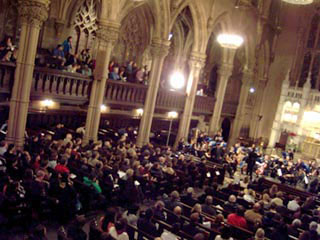 |
| Brooklyn Premiere of Peter Grimes at St. Ann and the Holy Trinity |
On January 25 and 27, 2008, One World Symphony performed Benjamin
Britten's masterpiece Peter Grimes (complete
and uncut) to capacity
audiences. One World Symphony also gave Peter Grimes its Brooklyn
premiere at St. Ann and the Holy Trinity. Many audience members
responded to One World Symphony's Peter Grimes performances
in New York City:
BRAVO! Bravi tutti! I wanted to thank you again for a very inspired performance. You did a fantastic job. I have seen Peter Grimes several times before and was pleasantly surprised that I heard colors and characters in the orchestra that I had missed all the other times. I found the evening to be at a very high level of musical, artistic and dramatic quality. One of the highest I have seen in New York. The complete and utter commitment to the musical and theatrical drama by you, the orchestra, the soloist and even the chorus was astonishing. From what I had the pleasure of enjoying last night, I guarantee you and One World Symphony have a great future ahead. All the best.
* * * * *
That opera [Peter Grimes] is certainly one of the greatest works of the 20th century, and high up there among the great operas of all time. It has a profound story and extraordinary music. But it also is a difficult opera to bring off -- and as always, I admire your daring! Besides the musicianship you always bring to your work, it takes real courage to take on a challenge like Grimes, especially given the minimal rehearsal time that is available for One World musicians. But it absolutely worked! From the very first note, it just swept along to his final despairing end, with everyone contributing beautifully to the whole. Britten's mastery of orchestral color and contrast came off especially well. The orchestra just played beautifully. Unfortunately, I didn't get a program, so I don't have the names of the singers at hand -- but your Grimes certainly looked and acted the part. He embodied Grimes' conflicted nature perfectly. Ellen and the Captain also sang beautifully. The entire cast did well as an ensemble, and that is no easy thing, especially in those tight spaces and having to walk up and down stairs! I thought the church scene, with the organ and choristers upstairs, was especially effective and moving. Congratulations on a beautiful, moving performance. I'm looking forward, as always, to the rest of your season.
* * * * *
What an emotionally gripping afternoon. My friend and I were originally planning to leave after the second act but decided to stay until the end. I'm so glad that we did. Your production was incredibly intense and engaging, especially the female quartet, Moonlight and Storm Interludes, church and the final scenes with the balcony chorus. Due to Peter's heartfelt performance, it was hard not to feel sorry for him. Thank you for sharing a truly moving performance.
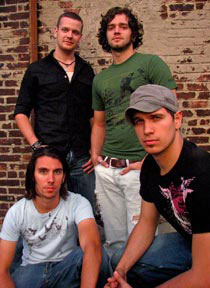 The Fault Line, America’s Hottest New Vocal
Rock Band, Debuts With One World Symphony in Queen’s Bohemian
Rhapsody.
The Fault Line, America’s Hottest New Vocal
Rock Band, Debuts With One World Symphony in Queen’s Bohemian
Rhapsody.
Bringing a cappella to an edgier level, The Fault Line will collaborate for the first time with a symphony orchestra -- New York’s own One World Symphony on March 7 and 9, 2008. The vocal rock band and New York’s hippest orchestra will perform Queen’s magnum opus Bohemian Rhapsody, a world premiere arrangement for vocal rock band, chorus, and symphony by Jihwan Kim and artistic director and conductor Sung Jin Hong.
The Fault Line took America by storm last year when it won Harmony Sweepstakes' first place prize as well as audience favorite and was a finalist in NBC’s America’s Got Talent.
The Fault Line and One World Symphony, under the baton of conductor Sung Jin Hong, will captivate audience members of all ages and tastes with active participation throughout the program. Tickets will be available at the door 30 minutes before each performance. Don’t miss this adventurous fusion between metal and classical.
One World Symphony Performs The Rite of Spring with Artworks by Harlem Children's Zone
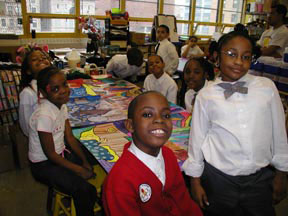 |
| Student artists from the Harlem Children's Zone Promise Academy I |
Artwork created by third graders of the Harlem Children's Zone (HCZ) Promise Academy I will be featured during the 80-member One World Symphony's performance of Stravinsky's The Rite of Spring at Ansche Chesed Synagogue on Sunday, April 13, 2008 at 4:00 p.m.
Conductor Sung Jin Hong will lead One World Symphony in Stravinsky's The Rite of Spring while student artwork inspired by the piece will project across a 15-foot by 22-foot screen. Under the guidance of art teacher Jill-Ashley Hummel Park, more than 80 students of HCZ's Promise Academy created their visual works inspired by painter Wassily Kandinsky and composer Igor Stravinsky.
The Harlem Children's Zone Inc., under the direction of President/CEO Geoffrey Canada, targets a 100-block area of Central Harlem with a wide range of educational and social services.
Now in its seventh full season, New York City's One World Symphony continues its mission to actively engage its audiences through musical innovation, championing living composers, and collaboration with all art forms.
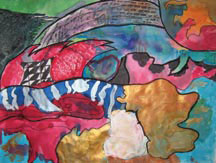 |
| Artwork by Bryan Clementson |
"Third grade students of Harlem Children's Zone (Promise Academy I) created abstract compositions inspired by the painter Wassily Kandinsky. Kandinsky was fascinated by the musical and visible world," explains Jill-Ashley Hummel Park, art teacher at The Promise Academy I. "His paintings were motivated by the imaginative and emotional power of music. The students used mixed media to create 18"x 24" paintings. They focused on using color symbology and rhythmic lines. Their work reflects personal feelings that were inspired by Stravinsky's The Rite of Spring. Stravinsky's music is harmonically adventurous and colorful, reflecting the evolution of the season. One World Symphony performs Stravinsky's The Rite of Spring with a slideshow presentation of abstract artwork. Synergizing the two will make for an uplifting and exciting event!"
"My music is best understood by children and animals." – Igor Stravinsky
 Songs of Summer: Brooklyn Paper's feature article on its season opener Italian Summer
Songs of Summer: Brooklyn Paper's feature article on its season opener Italian Summer
by Mike Edison
for The Brooklyn Paper
When I heard that the exceedingly hip and energetic One World Symphony would be launching their new season with a program called “An Italian Summer,” my scholarly, erudite reaction was, “Huh?”
In the conservatory where I studied, we were taught that playing this sort of thing in September was the baroque equivalent of wearing white shoes after Labor Day — it simply was not done. (Actually, beyond any fashion faux pas, I was afraid that all this warm-weather music might be some kind of metaphor for global warming. Apparently, I am a victim of my times.)
“We thought it would be a great idea to extend the summer experience with a different take on the nostalgia that an Indian summer evokes,” explained Sung Jin Hong, One World’s charismatic and poetic artistic director. “Our ‘Italian Summer’ program conjures feelings and images of butterflies on a passionate fling, or the raucous debauchery of a night at Bohemian Hall.”
Well alright, then.
The program begins with Respighi’s “Pines of Rome” (1924), which is basically four postcards from the city that brought us “La Dolce Vita.” A travelogue of sorts, kind of like when Duke did “Harlem” (or the Stooges did “LA Blues”). This is slightly less groovy than “Harlem” (and a lot more listenable than the Stooges’ tune), but still easy enough to parse that even Ramones fans should be able to sort it out.
Ditto Vivaldi’s “Summer” from “The Four Seasons” (1723). For classical music neophytes especially, this is a helluva place to start. One nice thing about it (besides the fact that, despite its widespread popularity at brunches and PBS pledge drives, it is actually really good) is that it comes with an instruction manual, what they call “extra-musical” or “program” material — in this case a sonnet that you can follow along to, from the idyll breezes of the first movement, right through to the “thunders and roar” of the final “presto” section.
And get ready for a real blast, because, as maestro Hong explained, his orchestra is going to veer away from “the early music performance practice of the 18th century,” which entailed performing “with less vibrato and less musicians; with transparent lines; quick, athletic tempi; and crisp articulation.” Rather, Hong’s army of musicians will be championing “the modern traditional style” when they attack the Vivaldi, meaning that they’ll “perform with unrestrained vibrato — a lush, full-bodied sound and with the full strength of our string players — which number 30 plus.”
Anyone who thought that their Polyphonic Spree records sounded big is going to have their knickers blown off by this group.
The real bang on this bill, however, is Mascagni’s “Cavalleria Rusticana,” a one-act “verismo” that shook the opera world when it debuted in 1890. It’s got enough fireworks and confrontation (not to mention the famous, fantastically passionate intermezzo) to satisfy even the most jaded New Jersey wiseguy.
This is just the first evening of One World Symphony’s season, temptingly titled “Obsession/Possession.”
“I think many New Yorkers can relate, as many of us have some sort of an obsessive nature,” Hong shrewdly observed. “Is it our city that brings out our compulsive tendencies, or vice-versa?”
 Nightmare on Montague Street! One World Symphony's Halloween Treat: Brooklyn Paper's feature article on Halloween benefit
Nightmare on Montague Street! One World Symphony's Halloween Treat: Brooklyn Paper's feature article on Halloween benefit
By Mike Edison
for The Brooklyn Paper
You gotta hand it to One World Symphony. Where other classical music outfits are content to do the same old thing, One World's evil genius maestro, Sung Jin Hong has crafted a shrewdly sinister Halloween program at the St. Ann and the Holy Trinity church.
What better place to spend All Hallow's Eve than a gorgeous Gothic church — plus, it's a benefit, too!
The Oct. 31 program includes Berlioz's "Symphonie Fantastique"; Danny Elfman's creepy-crawly score from "Batman"; Bach's "Toccata and Fugue in D Minor," featuring St. Ann's towering, truly terrifying Skinner organ (and which easily could have been titled "Music to Dig Graves By"); and Mussorgsky's "Night on Bald Mountain" — the original dark and primal orchestration, not the watered-down Rimsky-Korsakov version!
Now, I may have been an Ozzy Osbourne fan in my younger, more lysergic days — but this One World program is a real black sabbath.
News 2013 • News 2012 • News 2011 • News 2010 • News 2009
News 2008 • News 2007 • News 2006 • News 2005




